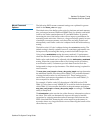
StorNext File System Tuning
Windows Memory Requirements
StorNext File System Tuning Guide 23
Therefore, DLC provides increased stability that is comparable to the
StorNext SAN Client.
Consistent
Security Model
0 DLC clients have the same security model as StorNext SAN clients. When
CIFS and NFS are used, some security models aren’t supported. (For
example, Windows ACLs are not accessible when running UNIX Samba
servers.)
Windows Memory Requirements
Beginning in version 2.6.1, StorNext includes a number of performance
enhancements that enable it to better react to changing customer load.
However, these enhancements come with a price: memory requirement.
When running on a 32-bit Windows system that is experiencing memory
pressure, the tuning parameters might need adjusting to avoid running
the system out of non-paged memory. To determine current operation,
open the Task Manager and watch the Nonpaged tag in the Kernel
Memory pane in the lower right hand corner. This value should be kept
under 200MB. If the non-paged pool approaches this size on a 32-bit
system, instability might occur.
The problem will manifest itself by commands failing, messages being
sent to the system log about insufficient memory, the
fsmpm
mysteriously dying, repeated FSM reconnect attempts, and messages
being sent to the application log and
cvlog.txt about socket failures with
the status code (10555) which is ENOBUFS.
The solution is to adjust a few parameters on the
Cache Parameters tab in
the SNFS control panel (
cvntclnt). These parameters control how much
memory is consumed by the directory cache, the buffer cache, and the
local file cache.
As always, an understanding of the customers’ workload aids in
determining the correct values. Tuning is not an exact science, and
requires some trial-and-error (and the unfortunate reboots) to come up
with values that work best in the customer’s environment.


















